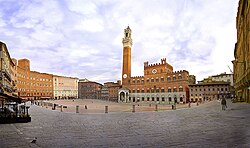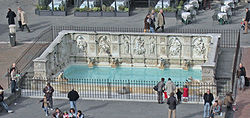Piazza del Campo

Piazza del Campo is the main public space of the historic center of Siena, a city in Tuscany, Italy, and the campo regarded as one of Europe's greatest medieval squares. It is renowned worldwide for its beauty and architectural integrity. The Palazzo Pubblico and its Torre del Mangia, as well as various palazzi signorili surround the shell-shaped piazza. At the northwest edge is the Fonte Gaia.
The twice-a-year horse-race, Palio di Siena, is held around the edges of the piazza. The piazza is also the finish location of the annual road cycling race Strade Bianche.
History
[edit]
The open site was a marketplace established before the thirteenth century on a sloping site near the meeting point of the three hillside communities that coalesced to form Siena: the Castellare, the San Martino, and the Camollia. Siena may have had earlier Etruscan settlements, but it was not a considerable Roman settlement, and the campo does not lie on the site of a Roman forum, as is sometimes suggested. The plaza was paved in 1349 in fishbone-patterned red brick with eight lines of travertine, which divide the piazza into nine sections, radiating from the mouth of the gavinone (the central water drain) in front of the Palazzo Pubblico. The number of divisions is held to be symbolic of the rule of The Nine (Noveschi) who laid out the campo and governed Siena at the height of its mediaeval splendour between 1292-1355. The campo was and remains, the focal point of public life in the city. Eleven narrow, shaded streets radiate from the plazza into the city.
The palazzi signorili that line the square were housing of the families of those who dominated governance of the city at the time, such as the Sansedoni, the Piccolomini, and the Saracini. Their homes have unified rooflines, deliberately built to demonstrate a sense of decorum in contrast to earlier high tower houses — seen as emblems of communal strife — such as may still be seen not far from Siena at San Gimignano. In the statutes of Siena, civic and architectural decorum was ordered: "...it responds to the beauty of the city of Siena and to the satisfaction of almost all people of the same city that any edifices that are to be made anew anywhere along the public thoroughfares... proceed in line with the existent buildings and one building not stand out beyond another, but they shall be disposed and arranged equally so as to be of the greatest beauty for the city."[1] The unity of these Late Gothic houses is effected in part by the uniformity of the bricks of which their walls are built: brick-making was a monopoly of the commune, which saw to it that standards were maintained.[1]
At the foot of the Palazzo Pubblico's wall is the late Gothic Chapel of the Virgin built as an ex voto by the Sienese, after the terrible Black Death of 1348 had ended.
Fonte Gaia
[edit]
The Fonte Gaia ("Joyous Fountain") was built in 1419 as an endpoint of the system of conduits bringing water to the city's centre. It replaced an earlier fountain that had been completed about 1342 when construction of the water conduits was completed. Under the direction of the Committee of Nine, many miles of tunnels were constructed to bring water in aqueducts to fountains and thence to drain to the surrounding fields.
A center of attraction for the many tourists, the present fountain is in the shape of a rectangular basin that is adorned on three sides with many bas-reliefs featuring the Madonna surrounded by the Classical and the Christian Virtues, emblematic of Good Government under the patronage of the Madonna.[2] The white marble Fonte Gaia was originally designed and built by Jacopo della Quercia, whose bas-reliefs from the basin's sides are conserved in the Ospedale di St. Maria della Scala in Piazza Duomo. The original sculptures of goddesses featured on the 1419 fountain were replaced in 1866 by free copies by Tito Sarrocchi, who omitted Jacopo della Quercia's two nude statues of Rhea Silvia and Acca Larentia that the nineteenth-century city fathers found too pagan or too nude. When they had been set up in 1419, Jacopo della Quercia's nude figures were the first two female nudes, who were neither Eve nor a repentant saint, to stand in a public place since Antiquity.[citation needed]
Notes
[edit]- ^ a b Richard Ingersoll (Rice University), Cities in History, Lecture 10: "The Uses of Decorum: Siena and the Nine"
- ^ Richard Krautheimer, "A Drawing for the Fonte Gaia in Siena" The Metropolitan Museum of Art Bulletin New Series, 10.6 (June 1952), pp. 265-274, discusses the evolution of the project, 1408-1419.

